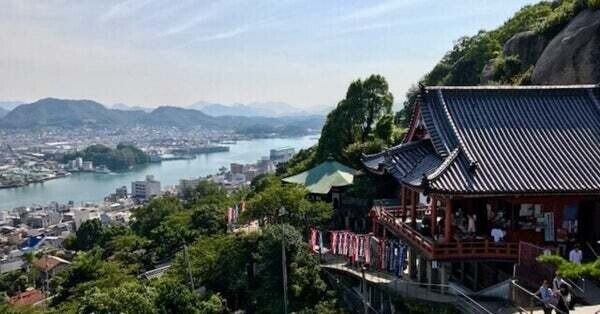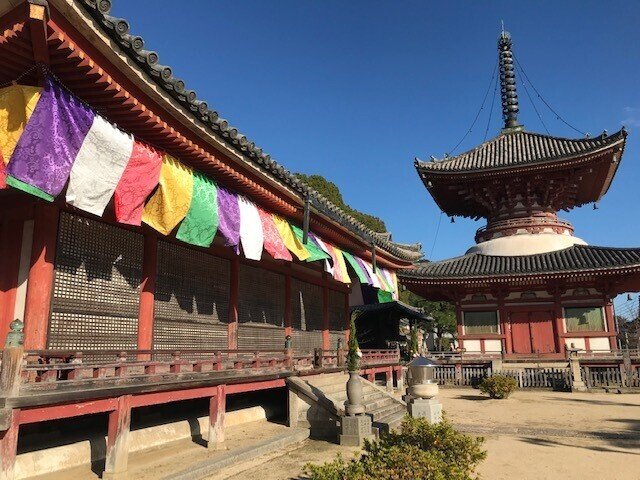
歴史ストーリーのある日本遺産のまち「尾道」が注目され続ける理由 !? そのⅠ「寺院の存在」 The reason why Onomichi, a Japanese heritage town with a historical story, continues to attract attention !? Part I "Existence of a temple"
尾道市は広島県の南東部に位置する、人口13万1千人(平成27年と調査)を有し、商業を中心とした町として平安時代から現代に至るまで栄え続けている町である。昭和の40年代以降の高度成長期の造船業をはじめ、漁業や海産物加工業、製造業、農業をベースに、現在(新型コロナ以前)では観光業による収益もかなり伸びている。
Onomichi City is located in the southeastern part of Hiroshima Prefecture, has a population of 131,000 (surveyed in 2015), and has continued to prosper from the Heian period to the present day as a town centered on commerce. Based on the fishing industry, marine product processing industry, manufacturing industry, and agriculture, including the shipbuilding industry during the high-growth period after the 1940s, the tourism is currently (before the new Corona), and profits from the tourism are increasing considerably.
新型コロナウィルス騒動前までは、国内外から年間700万人近い観光客が訪れていた。それに貢献したのが、「日本遺産」への登録、そして四国までの「しまなみ海道」開通が大きく貢献し、風光明媚な町として人気を集めている。
その土台を築いているのが瀬戸内を代表する歴史ストーリーである。一つは、瀬戸内海を拠点に活動した村上水軍(海賊衆)のヒストリアル。一方の山では寺院の勢力が尾道の歴史を築く大きな礎になり、尾道の発展に寄与しているのは間違いない。
Before the new coronavirus turmoil, nearly 7 million tourists from Japan and abroad visited each year. The fact that it was registered as a "Japan Heritage" and the opening of the "Shimanami Kaido" to Shikoku greatly contributed to this, and it is gaining popularity as a scenic town.
The historical story that represents Setouchi is laying the foundation. One is the historical history of the Murakami Suigun (pirates) based in the Seto Inland Sea. There is no doubt that the power of the temple on one mountain has become a major foundation for the history of Onomichi and has contributed to the development of Onomichi.

寺院が並ぶ尾道市街地
平安時代に、尾道の北部に位置する世羅町のあたりに豪族が管理していた備後大田庄の荘園があり、その倉敷地(穀物類を貯蔵するところ)として荘園米の積み出し港となって以来、貿易船や北前船などの寄港地として繁栄をとげた。
それぞれの時代の中で力をつけた豪商たちが尾道の地に寺院を作り寄進したといわれている。当時、豪商は働く人たちの神仏崇拝に力を入れ、とくに漁師や浜旦那(漁師を統括、魚介類などを卸す商人))は危険と隣り合わせの海を相手にしていたことから神仏に海上安全を祈願するために尾道に多くの寺院ができた。この瀬戸内海の天然の良港として栄えた尾道は寺院と共存共栄しながら時代を経てきた。
In the Heian period, there was a manor of Bigo Otasho, which was managed by a powerful family, around Sera Town, which is located in the northern part of Onomichi. Prospered as a port of call for trade ships and Kitamaesen(ship). It is said that the wealthy merchants who gained strength in each era built a temple in Onomichi and donated it.
At that time, the wealthy merchants focused on worshiping the gods and Buddhas of the workers, and especially the fishermen and beach masters (the fishermen who supervise the fishermen and wholesale the fish and shellfish)) dealt with the sea next to the danger, so they went to the sea to the gods and Buddha. Many temples were built on the tail road to pray for safety. Onomichi, which prospered as a natural good port in the Seto Inland Sea, has passed the times while coexisting and co-prospering with temples.
現在、尾道の三山といわれる「大宝山 千光寺」、「転法輪山 浄土寺」、「摩尼山 西國寺」など真言宗系の大本山を中心に、それぞれの塔頭を含め25カ寺が存在する。時代をさかのぼると、寺院の数で一番多かったときで60数カ寺あっといわれている。
そして、寺院が建立された理由の一つに、千光寺の巨岩をみるように三山のどの山にも大きな岩があり、神聖な場所とされたことが建立に大きく影響したといわれている。境内のあちこちに存在する大きな岩は御神体として人々に信仰されやがて修行の場となった。それがいつしか仏教と結びつき寺院建立へつながっていった。地元の労働者の安全祈願の寺院という役割に加え、修行の場として魅せられ多くの人が集まってくるようになったのが平安時代の終わりごろからである。
Currently, there are 25 temples, including the heads of each, centered on the main temples of the Shingon sect, such as "Daihozan Senko-ji", "Tenporinzan Jodo-ji", and "Manisan Saigoku-ji", which are said to be the three mountains of Onomichi.Going back in time, it is said that there are more than 60 temples when the number of temples was the largest.
And it is said that one of the reasons why the temple was built was that there are big rocks in every mountain of the three mountains like the huge rock of Senko-ji, and that it was made a sacred place had a great influence on the construction. The large rocks that existed here and there in the precincts were worshiped by people as a sacred body and eventually became a place of training. It eventually led to the construction of a temple in connection with Buddhism. In addition to the role of a temple to pray for the safety of local workers, it was around the end of the Heian period that many people began to gather as a place of training.


千光寺本堂横のご神体の巨岩(上) 岩肌に建つ千光寺本堂と尾道水道(下)

浄土寺本堂と多宝塔(共に国宝)

仁王門にはシンボルである2mの大草鞋が吊されている
余談ではあるが、調べていくと、聞きなれない仏教宗派「時宗(じしゅう)」の寺院が大きな役割を果たしたようだ。尾道にはその時宗の寺院が6カ寺もある。全国的にみても一つの町にこれだけの時宗寺院が集まっているのは珍しい。時宗は鎌倉時代の末期に興った浄土教の一宗派で、開祖は一遍上人といわれている。総本山は神奈川県藤沢市にある清浄光寺である。時宗寺院には当時の「浜旦那」の隆盛と深くかかわっていたというものが多く所蔵されている。その中で、とくに時宗は人々を分け隔てなく受け入れ、同時に「文化の発信元」にもなったといわれている。
As an aside, when I looked it up, it seems that the temple of the Buddhist sect "Ji-shu", which I couldn't hear, played a big role. There are also 6 temples of the sect at that time in Onomichi. It is unusual for Ji-shu temples to be gathered in one town nationwide. Ji-shu is a sect of Pure Land Buddhism that emerged at the end of the Kamakura period, and its founder is said to be Ippen. The head temple is Shojyoko-ji Temple in Fujisawa City, Kanagawa Prefecture. Many of the Ji-shu temples are deeply related to the prosperity of the "Hama-master" at that time. Among them, Ji-shu in particular is said to have accepted people without discrimination and at the same time became a "source of culture".
平安時代の終わりごろからから寺院を支え、江戸時代でも尾道には豪商がたくさんいて寺や神社を支えてきた。尾道の魅力でもある古い寺院や神社のほとんどが貴族や武士でなく商人によって建てられ、人々を支えてきた。 そして現在でも、尾道三山を始めとする寺院が歴史ストーリーをたずさえ数々の新しい情報を発信している。その文化に支えられてこそ、新しいものが生み出されていく。そしてまた次の世代へと繋がっていく。尾道の魅力を育んだのは、この瀬戸内海の地形によって創造されたものが時代を経ていまに繋がっている。そこには「寺院」の存在なくして尾道はあり得ないと言っても過言ではない。
It has supported temples since the end of the Heian period, and even in the Edo period, there were many wealthy merchants in Onomichi, supporting temples and shrines. Most of the old temples and shrines that are also the charm of Onomichi were built by merchants rather than aristocrats and samurai and have supported people. Even now, temples such as Onomichi sanzan are sending out a lot of new information even with historical stories. Only with the support of that culture will new things be created. And it will lead to the next generation again. What brought up the charm of Onomichi is that what was created by the topography of the Seto Inland Sea has been connected over time. It is no exaggeration to say that Onomichi would not be possible without the existence of a "temple" there.
リポート&写真/ 渡邉雄二・栗山主税 Reported & Photos by Yuji Watanabe・Chikara Kuriyama
よろしければサポートお願いします。日本の伝統文化に関心を寄せています。若いころに文化圏の異なる地域の方たちとの交流で日本のことをあまりにも知らなかったことに気づかされ、それがきっかけで広く浅く学んでいます。拙いレポートですが、お目に留めていただければ幸です。
